Sikhi and Hinduism
While Sikhs believe that Sikhi/Sikhism has borrowed nothing from Hinduism, here are some counter facts.
There is a new breed of Sikh scholars who bend backward to prove Sikhism has taken little or nothing from Hinduism. All they need to be told is that of the 15,028 names of God that appear in the Adi Granth, Hari occurs over 8,000 times, Ram 2,533 times, followed by Prabhu, Gopal Govind, Parbrahm, and other Hindu nomenclature for the Divine. The purely Sikh coinage ‘Wahe Guru’ appears only sixteen times. Source
Similarly, there are claims that Sikhs don’t celebrate Diwali but Bandi Chor Diwas, even though, Guru Amar Das still called it Diwali. While other Sikh festivals like Hola Mohalla coincides with Holi. And Baisakhi predates Sikhi. Even the tradition of langar even though the similar concept of public feasting predates Sikhi. No Sikh festivals coincide with Muslim festivals, the other dominant religion of India in the 15th century.
Then there are claims that Guru Nanak didn’t wear Janeu, even though he questioned the hypocrisy of wearing one without good actions. In fact, as per the earlier authentic sources, he did wear Janeu and ordained Tilak.
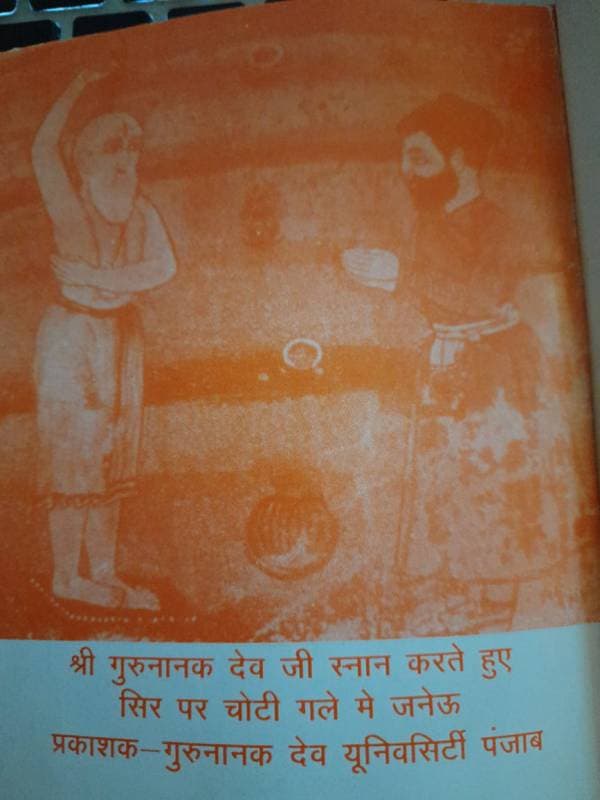
Here is an old Sikh painting of Guru Nanak (seated in the middle) along with Bhai Bala and Bhai Mardana. His Tilak on the forehead can clearly be seen. There is a Rudraksha Mala in his hand. Notice his ears are also pierced. A Sikh scholar has also posted in detail that ear piercing was the norm among the gurus.
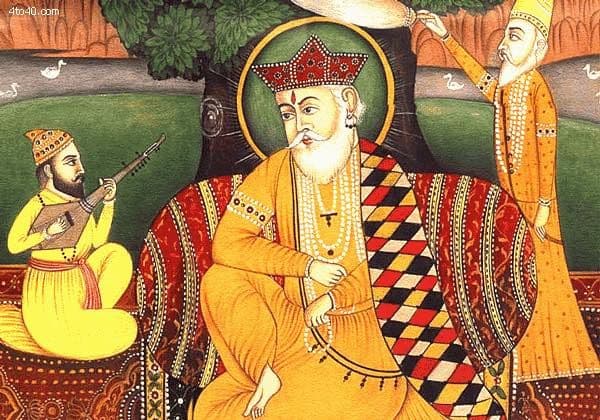
Illustration from Janamsakhi. Sikh painting (c. 1800)
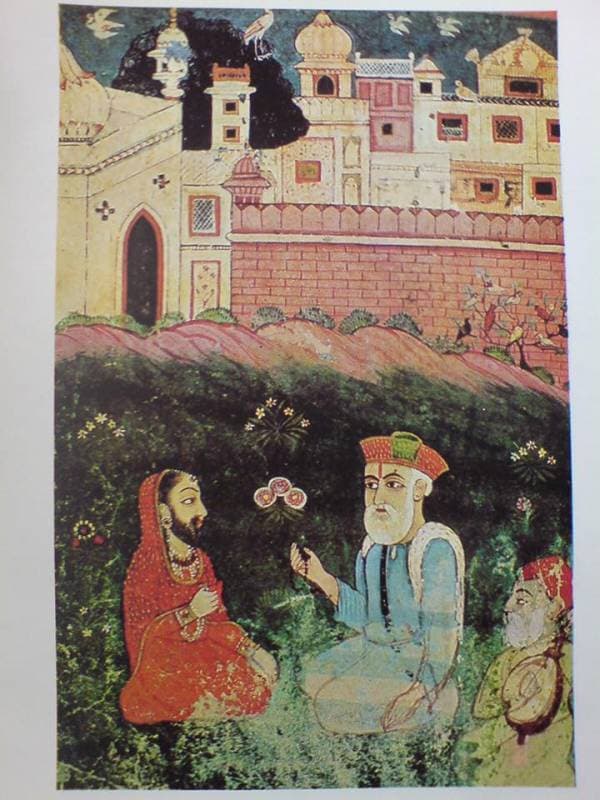
Guru Nanak meeting Sheikh Sharf. Illustration from Janamsakhi. Early Sikh painting (c.1700). Guru Nanak (centre) is clearly shown with a Tilak and Seli Topi.
Another depiction of Guru Nanak (second from left) from the 300-year-old Baba Ram Rai Darbar. Again, his Tilak is very noticeable.
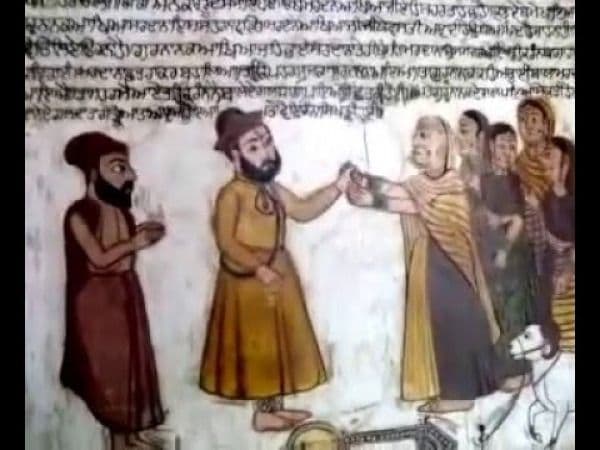
Painting of Guru Nanak, seated in the middle, with Bhai Bala and Bhai Mardana. His Tilak and Vaishnav Seli Topi can clearly be seen.
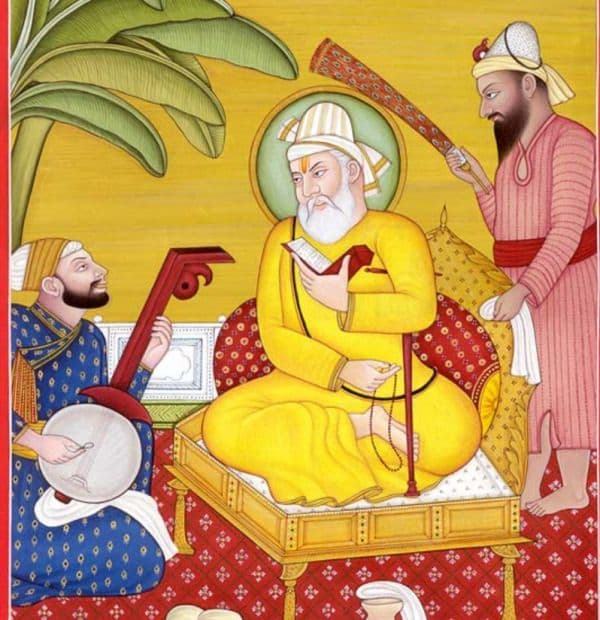
Another painting of Guru Nanak with his son Sri Chand. This painting is from Dera Baba Nanak Gurudwara which was set up by the descendants of the Guru.
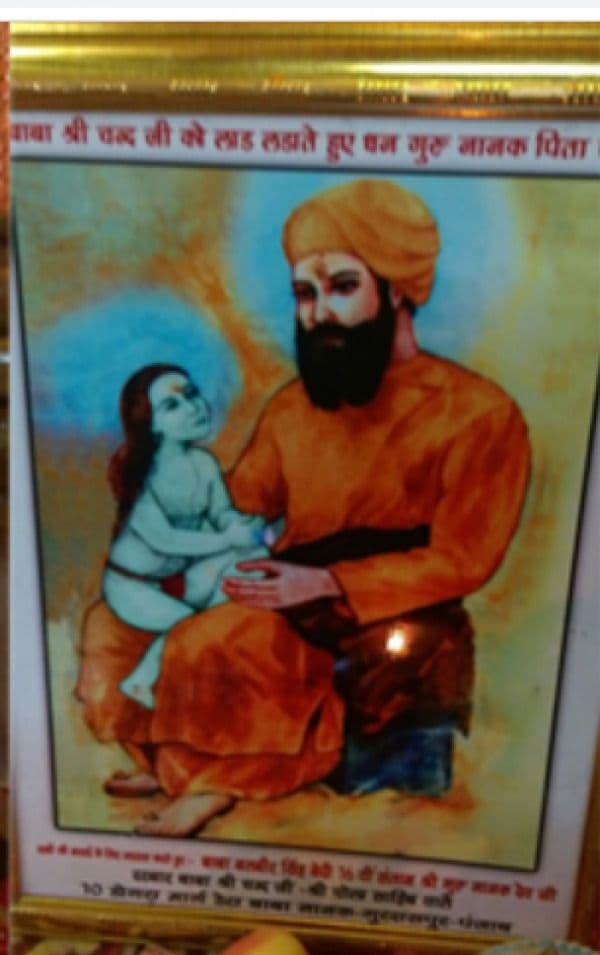
Here is a personal collection of Guru Nanak’s Seli Topi, Rudraksha, Shaligram, and his handwritten copy(pothi) preserved by descendants of Guru Amar Das who had set up their headquarters in Guru Har Sahai (Punjab).
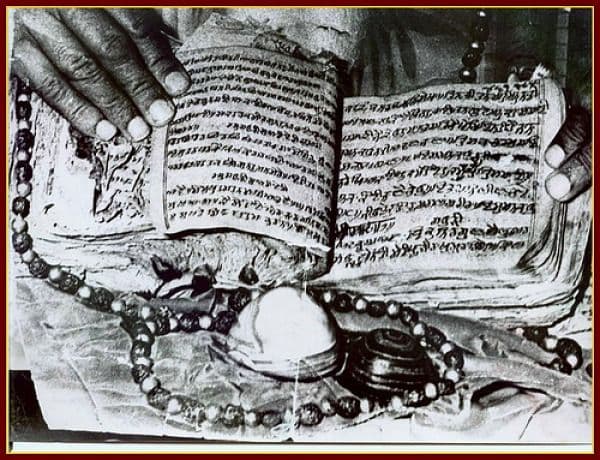
GuruAngad was a priest of a Durga temple & he’d annually lead devotees to JwalaMukhi Shaktipeeth.
On one such pilgrimage he met #GuruNanak & both realized other was their future.
Underlined bit reads: अंगद जी भऊणी चलिआ or Respected Angad walks to Bhavani.
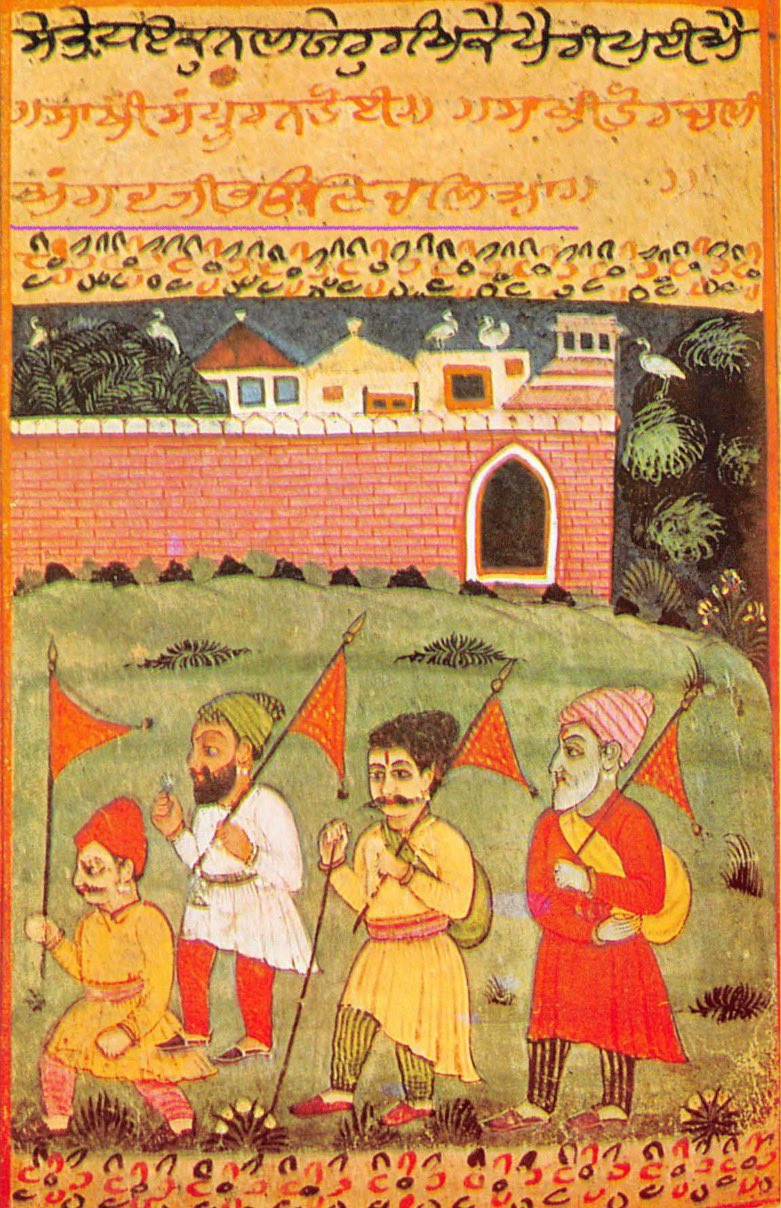
Even the Sikh khanda symbol has been seen in similar forms been associated with Shiva.
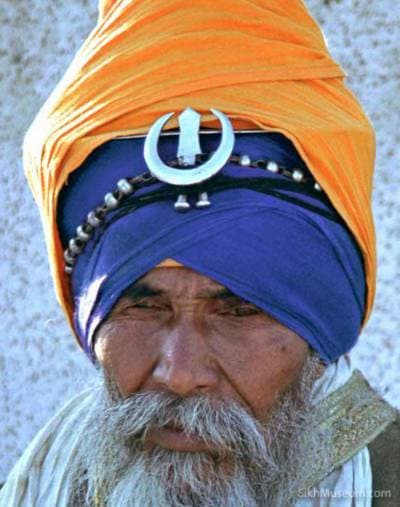
Similarly, in the (prachin) Panth Prakash (page 850), it is mentioned that at the time of his wedding, Guru Govind Singh wore Janeu.
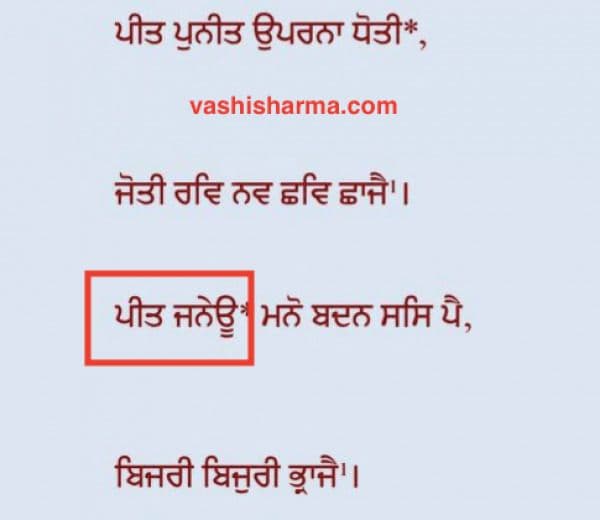
In fact, the gurus read and praised about Vedas. Guru Nanak Dev wrote, “What can the Riches of Vedas do for a person who does not possess intellect”.
The original Guru Granth Sahib had depicted the 10 gurus around Maa Durga on its cover.
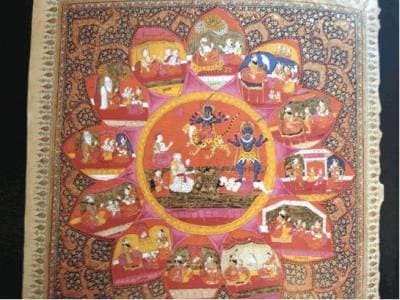
The oldest known copy of Dasam Granth whose authorship is attributed to Guru Gobind Singh. The date on the manuscript is 1698. The cover shows Guru Gobind Singh praying reverently to a Goddess who mounts on a lion.
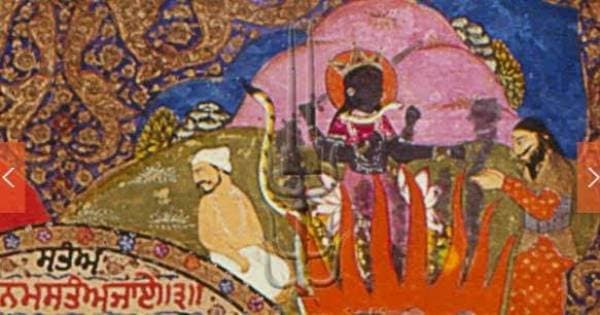
Almost 50% (22/43) of authors of Guru Granth Sahib were Brahmins. This includes the 17 Bhatts and 5 Bhagats (Beni, Jayadeva, Surdas, Ramanand, Parmanand). The Bhagats lived before the advent of Sikhi. The descendants of the families of Bhatts have not accepted Amrit and initiated into Khalsa order.
The word ‘Waheguru’ was first coined and used by a Brahmin named ‘Bhatt Gayand’. The Bhatts were Hindu Brahmins who wrote that the Sikh Guru Angad is an incarnation of Raja Janaka. Their verses are included in Guru Granth Sahib. The Bhagats like Jayadeva, Ramananda and Paramananda were Vaishnava Bhaktas who predated the birth of Sikhism. Their verses have been included in Guru Granth Sahib.
An illustration of Baba Budha anointing Guru Arjan Dev with Tilak. Frequently depicted in historic Gurudwaras. Guru Ramdas tilak anointment is mentioned even in Guru Granth Sahib.
ਰਾਮਦਾਸ ਸੋਢੀ ਤਿਲਕੁ ਦੀਆ ਗੁਰ ਸਬਦੁ ਸਚੁ ਨੀਸਾਣੁ ਜੀ
The Guru then blessed Sodhi Ram Das with Tilak
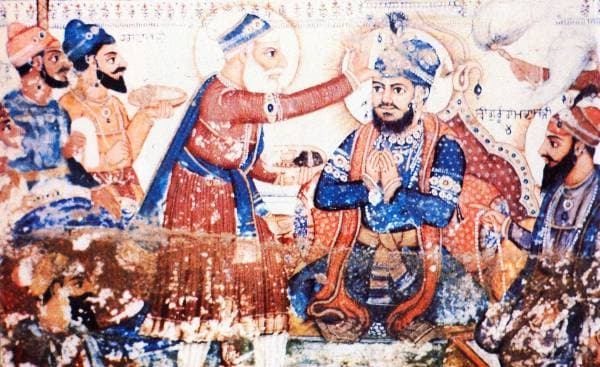
“Sikhs are still to a certain extent Hindoos. They worship the same deities as the Hindoos, and celebrate all their festivals; they derive their legends and literature from the same sources and pay great veneration to Brahmins.” - Observation by Wilson quoted in EIC gazetteer, 1858
Sikh army battle flag featuring Durga on the military banner
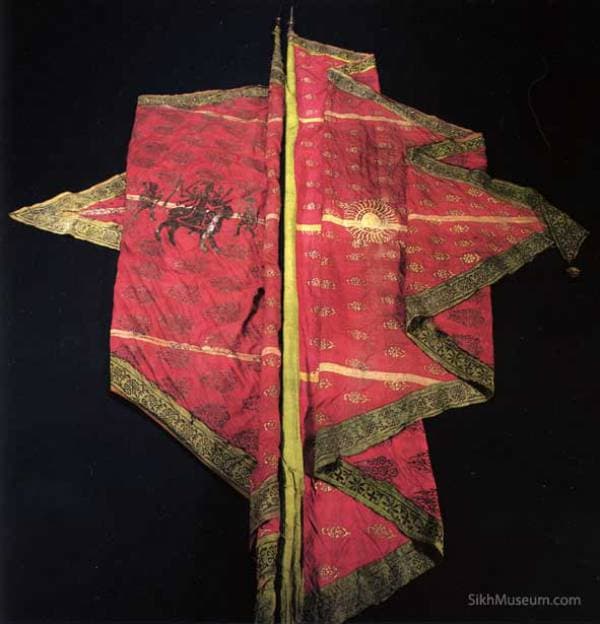
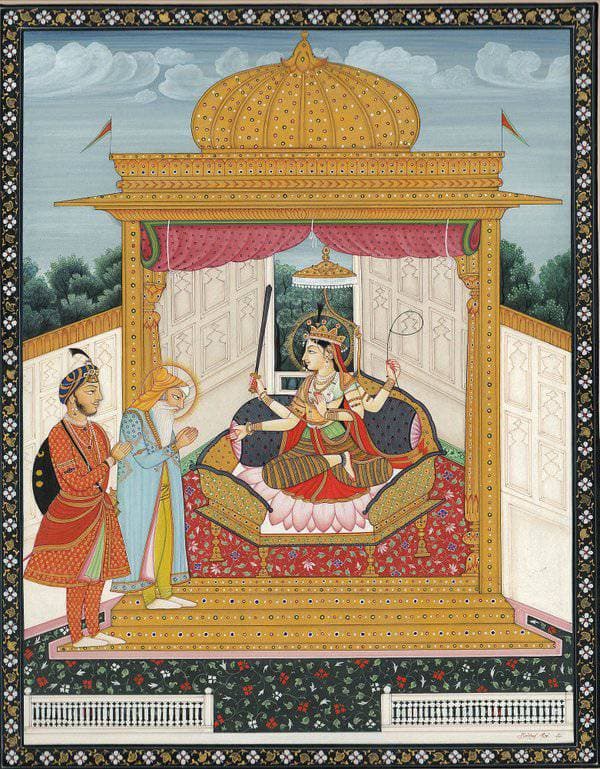
Maharaja Ranjit Singh worshipping Durga
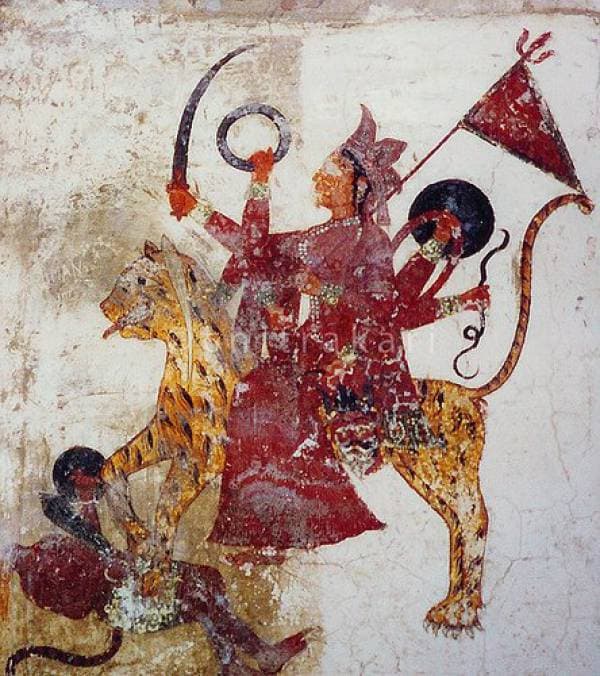
Frescoes of Durga in Sikh Gurudwara at Nurungabad c.1720 AD
In Gurugranth Sahib, Gurunanak calls his god by the name of Hari and says that their god is chaturbhuj (four-armed), Shyam Sundar(blue-skinned), and jadim rai(kings of Yadavas).
Maalee Gauraa, The Word Of Devotee Naam Dayv Jee:
One Universal Creator God. By The Grace Of The True Guru:
Blessed, blessed is that flute which the Lord plays.
The sweet, sweet unstruck sound current sings forth.
Blessed, blessed is the wool of the sheep;
blessed, blessed is the blanket worn by Krishna.
Blessed, blessed are you, O mother Dayvakee;
into your home, the Lord was born.
Blessed, blessed are the forests of Brindaaban;
the Supreme Lord plays there.
He plays the flute, and herds the cows;
Naam Dayv's Lord and Master plays happily.
Goddess Chandi on the sword of Guru Hargobind (c.1635 CE). This sword was apparently used in the battle against Painda Khan (The sword is now hosted in The Sikh Museum)
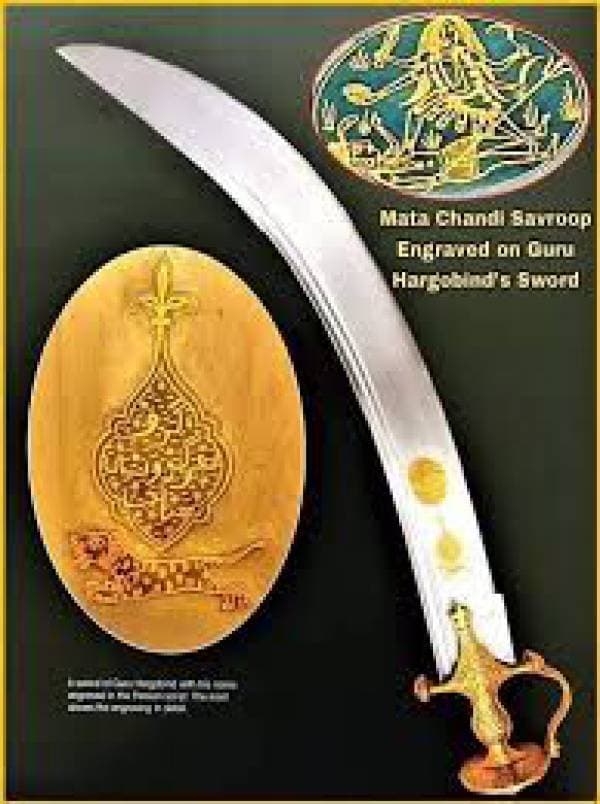
In old Sikh paintings, Guru Tegh Bahadur is depicted with Tilak like any Hindu. The second painting is housed in Lahore Museum. Nore that, this is not merely artistic convention. This is supported by history. Sikh chronicles attest that when Guru Tegh Bahadur when was anointed as the Guru, a Tilak was applied on his forehead. This incident happened on 11th August, 1664. It was a tradition among Sikh Gurus and Kings to be thus anointed with Tilak. This past has caused a lot of consternation and discomfort among the recent SGPC and Singh Sabha ideologues. Such paintings of Guru Tegh Bahadur with Tilak have completely vanished and are not found today. Instead, he is depicted like this in recent paintings.
Guru Tegh Bahadur identified himself as a Hindu and devotee of Naina Devi. He also identified himself as a kshatriya. The Guru called himself a descendant of Rishi Vishvamitra. We have contemporary primary evidence for this.
Guru Tegh Bahadur visited the holy Triveni at Prayaga in 1662 CE. This visit is documented in contemporary Bhat Vahi records. Unlike those unpublished “bhat vahis”, this one was published by Sikh historian Madanjit Kaur in Proceedings of the Indian History Congress in 1978.
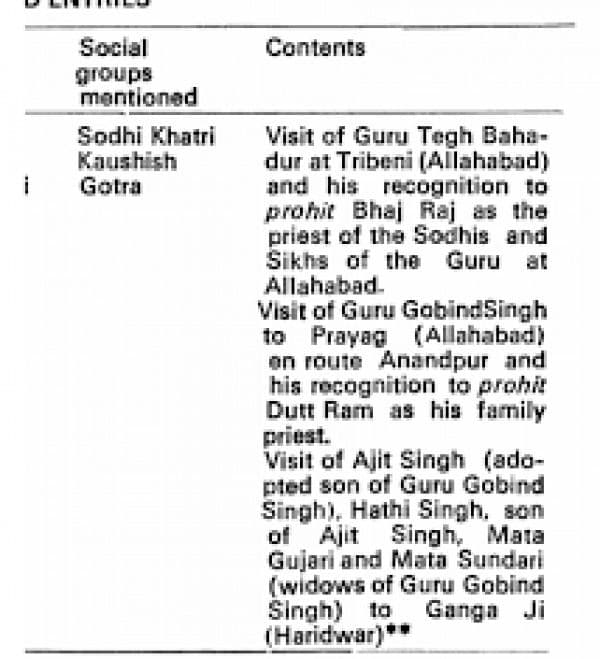
This Bhat Vahi was signed by Guru Tegh Bahadur. The content of the letter is particularly striking. Guru Tegh Bahadur calls himself a devotee of Naina Devi. Note that he does not mention Akal Purakh or Waheguru. Naina Devi remained a popular pilgrimage site for Sikhs for centuries. Even in 1968, Naina Devi temple drew more Sikh Pilgrims than Hindus. Of course, it is not the same anymore now.
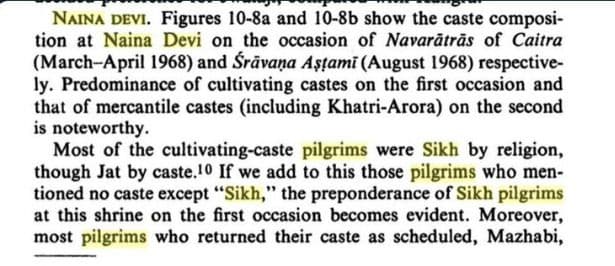
In the record, Guru Tegh Bahadur identifies himself as Sodhi Khatri by Varna and Kaushish by gotra. This is exactly how the followers of orthodox Hinduism identify themselves to this date. Note that, Kaushish/ Kaushik is the Gotra of Rishi Vishvamitra. Kaushika is just another name of Rishi Vishamitra. Gotra indicates descent from the Rishi.
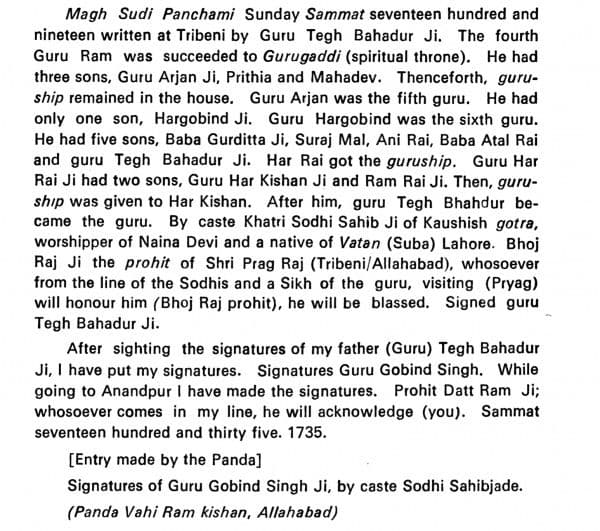
Further, Guru Tegh Bahadur appoints a brahmin purohit named Bhoj Raj. He orders Sodhi’s of his line and all his Sikh followers to obey the aforementioned Brahmin Purohit. This practice of appointing purohits is just what is referred to by some people as “Brahmanical Hinduism”.
Kavi Santokh Singh’s Sri Guru Pratap Suraj Granth preserves a very rare passage that throws light on what Guru Tegh Bahadur uttered in Mughal court. When the Guru was offered the choice of Islam or dεath in the Mughal court, this is what he said, “I believe my Hindu Dharma to be most superior. How can I abandon that which is most dear to me? Which gives so much happiness in this world & that, Life is nothing before honor.”
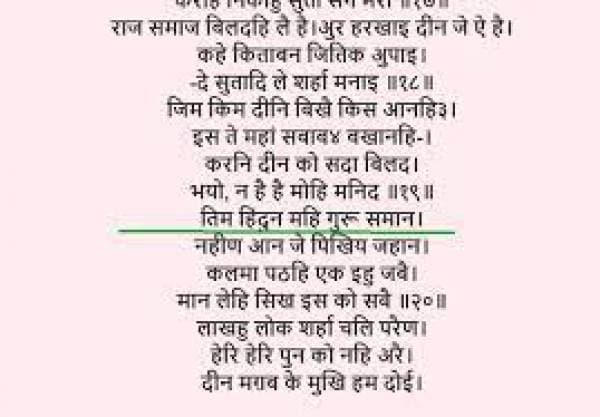
Finally, the Guru’s own passages preserved in Guru Granth Sahib corroborate that the Guru was every inch a Hindu. He says- “This is the blessing of Vedas and Puranas, that you may meditate in the name of Hari”. In the English, translation, many online sources change ਹਰਿ (hari) to Lord.

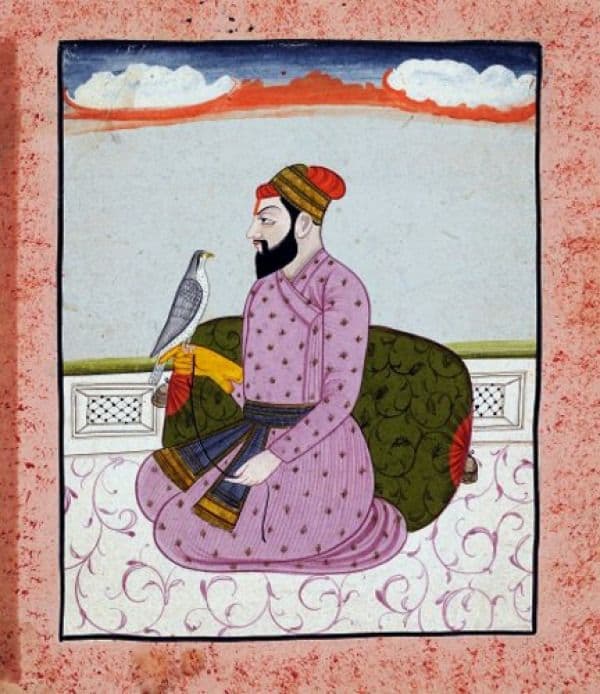
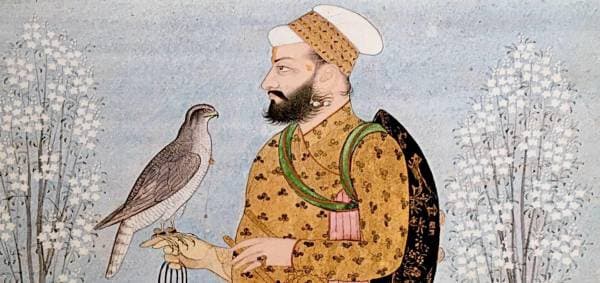
The second painting is housed in Lahore Museum (Acc. No. F-47)
Guru Tegh Bahadur celebrated Dipavali according to the injunctions of Puranas. In Puranas, it is stated that cattle & clothes should to be presented on the auspicious occasion of Dipavali. The same ritual was followed by Guru Tegh Bahadur as explicitly stated in his Hukumnamah. It is to be observed that Guru Tegh Bahadur refers to the festival as ‘Diwali’ and he does not use the word ‘Bandi Chor Divas’ in any of his writings. He celebrates the festival just as traditional Hindus did for thousands of years.
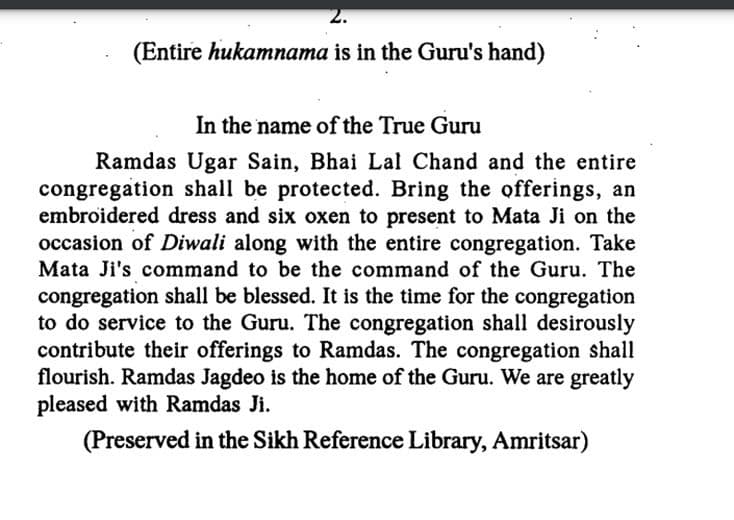
Source:
- https://twitter.com/BharadwajSpeaks/status/1361695601759412230
- https://twitter.com/TrueIndology/status/1638450412226506752
- https://www.searchgurbani.com/sri-gur-pratap-suraj-granth/page/461/volume/12/hindi
- "A study of the Panda Vahis" by Sikh historian Madanjit Kaur (Indian History Congress 1978)
Two sons of Guru Gobind Singh were brutally killed for not accepting Islam. Here are their [last words][last words] from Sri Gur Pratap Suraj Granth Volume 18, Rut 6, Ch 51, Verse 35-36 - Pg. 387
फते सिंघ सुनि अुज़तर दीना।
-धरम पितामे जोण रखि लीना।
शुभ जस ते जग पूरन कीना।
तीन लोक महि शाका चीना१ ॥३५॥
हम तुम को तिम ही बनि आवै।
सिर दिहु तुरकनि मूल गवावैण।
हिंदू धरम जाग है फेर।
तन सभि नाशवंत ही हेरि ॥३६॥
Or in English, we will sacrifice our heads for eliminating Turks and for reviving Hindu dharam.
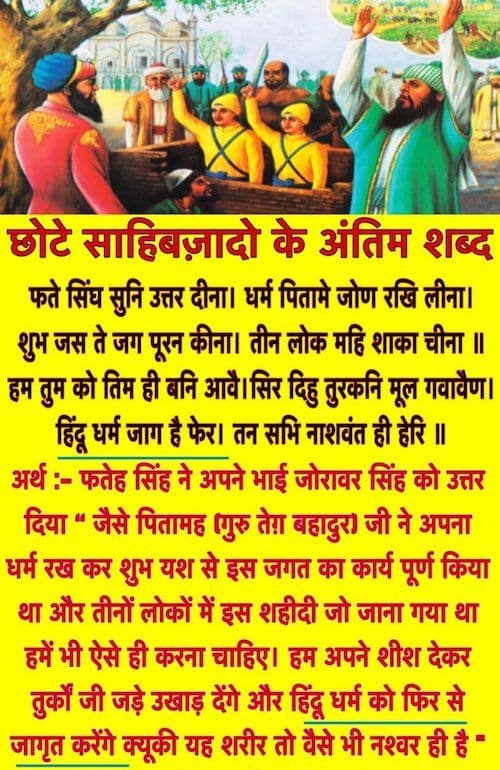
In 1628 AD, Guru Hargobind Singh visited Raja Kalyan Chand at his capital Kot-Kehloor. Rajahim patronage and gifted him the village of Kiratpur and Kalyanpur as Jagir. The Mughal Emperor Jahangir took objection to these relations between Raja and Guruji and asked Raja to remove Guru from the hill state of Kehloor. But Raja refused the emperor’s wish. Raja Kalyan Chand shifted his capital from Kot-Kehloor to Sunhani (Bilaspur). Guru Gobind was taught Shastra Vidya by Rao Bajjar Singh Rathore. Guru Gobind’s kids were taught by Rai Alam Singh Chauhan. He was saved at Chamkaur and given protection by Ghorewaha Kachwaha Rajputs. He made his Sikhs model the Rajput culture and uplifted them by making them adopt the Rajput culture including dressing style. His father and wife were saved by Jaipur kachwahas. He stayed under protection at Raipur rani, Ramgarh, and Chamba, Rajput ruled areas. His greatest general was Bachitar Singh Minhas. His sons’ killings were avenged by a Rajput Banda Vairagi. The most prominent victories of Sikhs got, was either under the command of Banda a Hindu Rajput or against divided Afghans who could never muster a large number of horsemen. The decline of the Mughals, Nadir’s invasion gave Sikhs their chance which they exploited.
Gurudwara Bangla Sahib was originally Bangla, that is, a palace, of great Hindu King Raja Jai Singh. When Aurangzeb summoned 6 year old Sikh Guru Har Krishan, Jai Singh protected the Guru & offered him residence here. He donated Bangla to Sikhs.
In 1661 AD, Aurangzeb summoned Guru Har Krishan. He wanted to take away Guruship from the Guru bestow it onto Ram Rai. The Great Rajput king Raja Jai Singh immediately realized that Guru’s life was in danger. He personally went to Kiratpur to pay respects to the child Guru.
Aurangzeb summoned Guru Har Krishan to Delhi. Violating the summon would only mean execution of the Guru. But the Guru was reluctant to go to Delhi. The Gurumata Krishan Kaur frankly said: “We will not go. We do not trust the Mughals. Nothing good has ever come from them”.
Realizing the blockade and danger, Jai Singh Said: “Mother, I take the responsibility of Guru’s safety. He will be my guest. I am a Rajput. This is a Rajput’s word. I wont allow a hair of the Guru to be touched. I will lay down my life for it. I will always be by his side”.
Mata and the Guru were convinced. The Guru accompanied Jai Singh to Delhi. Jai Singh was true to his word. He personally protected the Guru & acted as his personal ambassador. He petitioned emperor on Guru’s behalf. Jai Singh ensured Aurangzeb didn’t even lay his eyes on Guru.
While the Guru was at Delhi, Raja Jai Singh lodged the Guru in his personal Bungalow in outskirts of Delhi. Guru was treated with great respect & given every comfort. Many Sikhs came to visit Guru. After Guru passed away, palace was given to Sikhs and it later became Gurudwara.
When Guru Hargobind was attacked by Mughals, he was forced to leave Punjab plains for hills. Raja Tarachand of Kahlur received and protected Guru Hargobind. He did not pay homage to Shah Jahan. Raja Tarachand donated the land for the Guru. Here Guru Hargobind built Kiratpur.
According to Sikh historians such as Surjit Singh & Hardeep Syan, Kiratpur Sahib was built on a land that was donated by Raja Tarachand of Kahlur. Kiratpur was Raja’s territory. Raja Tarachand wasn’t subordinate of Mughals. His land provided full security to Guru from Mughals.
In November 1665, Guru Tegh Bahadur was arrested by Aurangzeb. Guru was about to be executed. The Hindu prince Raja Ram Singh pleaded with the emperor to rescind his order. Ram Singh eventually secured the release of the Guru. The Hindu prince saved & protected the Sikh Guru.
There is no historical proof of Gangu Brahmin, see the detailed article here
Raja of Kutlehar, a jagir in Himachal, received a sword from the family of Guru Gobind Singh. In 1700, when Mughals attacked Anandpur Sahib, Guru came to Kutlehar. The Raja of Kutlehar defied Mughal orders. He did not attack/hand over Sikhs to Mughals. When Mughals attacked, Guru was forced to leave his seat & seek safety in Kutlehar. Guru was in a very critical condition. In this situation,the Raja defied Mughal orders and protected the Guru from Mughals. For this indiscipline, Mughals punished Raja. His Jagir was reduced.
1708-1725: After Guru Gobind Singh ji passed away, the house of Guru Gobind Singh’s Dharmapatni Mata Sundari Ji, in Delhi was sacked. They were forced to leave Delhi. Sawai Jai Singh protected Guru’s wife & family from Mughals & provided them a good house in Mathura and handsome allowance for their subsistence.
Many Brahmins laid down their lives to protect the Sikh Gurus and their families. Take the case of Bhai Singha Purohit. He rescued the daughter of Guru Hargobind, Bibi Viro, from the hands of Mughals. He laid down his life in protecting the Guru.
Khalistan was first demanded in 1931. Indira was then just a schoolkid. In 1931, VS Bhatti of Akali Dal demanded Khalistan or Sikhistan with Ludhiana, Jalandhar, Amritsar, Rohtak, Ambala, and Shimla hill states. This was before the independence of India. Bhindranwale did not start the Khalistan movement. Khalistan movement existed long before Bhindranwale was born. Regarding the claim that Indira “rejuvenated” the Khalistan movement, this is also false. The Khalistan movement was already in swing. In 1969, Punjab’s ex-deputy speaker Jagjeet Singh Chauhan was campaigning in the UK for Khalistan. Bhindranwale was nowhere in the picture at that time.
What Indira Gandhi did was use the Khalistan sentiment to her political benefit. Because Akalis started the Punjabi Suba movement and were riding on separatist sentiments, Indira propped Bhindranwale who was even more extreme than Akalis. Yes, by encouraging someone like Bhindranwale, Indira had an undeniable role in encouraging the Khalistan movement the price for which she paid with her own life. But Indira neither created nor rejuvenated Khalistan. She tried to use the Khalistan sentiment for her political benefit. Thus, Indira encouraged one separatist to put another separatist in place. This is a very common tactic governments use to suppress separatist movements.
Revisionist Sikhs are presenting as if it was Hindus who were out to kill Sikhs. The fact of the matter is that the first Bhindrewala killed Sikhs as well as Hindus in large numbers. And the anti-Sikh riots of 1984 after Indira’s murder by her Sikh bodyguards were a Congress mob. Even Khuswant Singh wrote that BJP and RSS tried to save them.
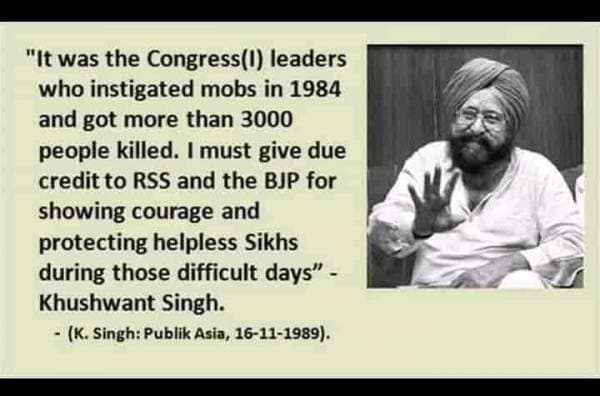
Supreme Court Advocate H.S. Phoolka : “1984 Violence was never a Hindu-Sikh riot. It was a planned massacre of Sikhs led by the Congress. Even some Muslim supporters of Congress were involved. Countless ordinary Hindus risked everything to shield their Sikh neighbours. I have seen this with my own eyes”.
ਮਮ ਸਿਖ ਤੁਰਕਣਿ ਸੰਗ ਨ ਕਰੈ ।
ਏਕ ਬਾਰ ਹੀ ਭੋਗੈ ਕੋਇ ।
ਮੁਸਲਮਾਨ ਸੋ ਤਤਛਿਨ ਹੋਇ ।
A Sikh of mine should not have, (physical), relations with a Turkni, (Muslim female). If one has sex even on a single occasion, He will become a Muslim at that very instant. Guru Gobind in Suraj Prakash
See Sikhi and Yoga
See Sikhi and cow